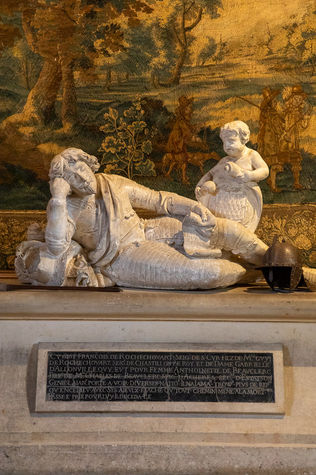
the history of chateau de meillant
Château de Meillant is surrounded by 5 hectares in the heart of France. Immerse yourself in the exceptional family history of Château de Meillant, which has endured for over
for over 1,000 years.
Discover this private castle and all the jewels it contains.

11th century
A castle already existed in the 11th century.
A tower had been built by a member of the Charenton family, a younger branch of the princely house of Déols.
This tower was built to protect his lands from the large tower that had been built at Dun-le-Roi, now Dun-sur-Auron, a few kilometres away...

1473
It was the d'Amboise family, and in particular Charles de Chaumont d'Amboise, Governor of Italy, who transformed the castel.
Most of the current structure (the main central building and the chapel) was built by Charles de Chaumont d'Amboise, chamberlain and adviser to Louis XII, from 1473.
Following a visit by King Louis XII, Charles de Chaumont had part of the Saracen Tower covered with a lead cap featuring a golden crowned porcupine (the King's emblem) with twelve golden Ls and twelve golden fleurs-de-lis.

1510
In the early 16th century, Charles II d'Amboise modified the courtyard façade and created the Lion Tower, the only one of its kind. He had the tower and the high windows of the façade lavishly decorated, intertwining the ornamentation with the sculpture of his cipher, two interlaced Cs, and his coat of arms, the fiery mounts.
The Lion Tower, named after the lion that towers above it, was built as an hors-oeuvre and includes a spiral staircase in the Louis II style, marking the transition between the flamboyant Gothic and early French Renaissance styles.
In 1527, the popular saying "Milan a fait Meillant" ("Milan has made Meillant") was coined, referring to the gains made by Charles de Chaumont during his time as governor, and making Meillant one of the most beautiful residences of the period.

1842
In 1842, the Duchess of Mortemart, born Virginie de Sainte-Haldegonde and her husband, the Duke of Mortemart, heirs to Meillant, decided to restore it for the third time. The architect Louis le Normand redid the sculpted decoration on the exterior, the roofs and the parapets, and rebuilt the upper storeys of the main buildings at the eastern end of the castel. He also completely overhauled the interior, including the vast guards' room, entirely decorated with restored weapons and armour from the olden days. Numerous halberds and pikes, placed and arranged all along the walls, recall the warrior spirit of the knights of yesteryear.

1926
By decree of 2nd March 1926, the castel was listed as a Historic Monument, and this was subsequently extended: all of the castel's facades and roofs have been listed as Historic Monuments since 4th April 1963.

1944
The château was used as an infirmary. Wounded Resistance fighters were evacuated to the hospital in Dun-sur-Auron or received treatment at the château de Meillant, where what is now the guardroom was converted into a clandestine infirmary at the request of the Mortemart family. A plaque at the entrance to the guardroom, donated in 1991 by the former members of the 1st Infantry Regiment, bears witness to this.

a family home
with a sumptuous decor
As the residence is private and sometimes still inhabited, it is not possible to take photos of the interior
but here are a few details of the castle's interior, as a foretaste of the guided tour.

Immerse yourself in the history of the jewel
of the castle :
the lion's tower.
Discover all the wonders and symbols of this masterpiece of flamboyant Gothic art on our new guided tour. At the top of the tower, a room with mysterious paintings and a superb view over the rooftops and the park...
Saturdays, Sundays and public holidays only,
booking mandatory.

rochechouart de mortemart family
Originally from the Limousin region, France's oldest family has owned the estate for over 200 years.
The Marquise de Montespan remains the most famous of its illustrious representatives.
The Dukes of Mortemart adapted the château to the tastes of the 19th century, turning Meillant into the family home that many are discovering today.
As you wander through the various rooms, you'll be able to soak up the singular atmosphere and observe the constant attention to detail and aesthetics - each generation having preserved and maintained this family heritage.
aimery de mortemart
Since the Second World War, Aimery de Rochechouart, Marquis de Mortemart, who continues to occupy the castel today, has been responsible for the upkeep and preservation of this grand house, following in the footsteps of his ancestors and parents.
Among other things, he restored the roofs and the 16th-century chapel. Meillant is now consolidated and restored, like the phoenix rising from its ashes.











